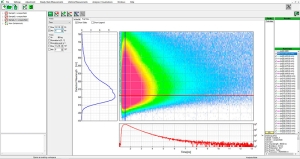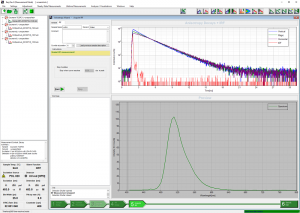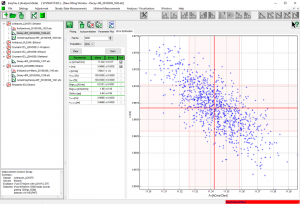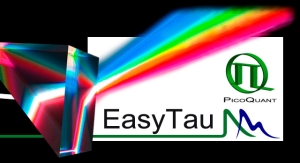Software
EasyTau 2
Data Acquisition and Analysis Software
- Combined solution for hardware control, data acquisition and analysis in FluoTime 300 and FluoTime 250 spectrometers
- Three modes of operation depending on users requirements
- Powerful scripting language for automation (local or remote)
- Steady-state and global decay analysis with robust error analysis
- Fitting software for TCSPC electronics in histogramming mode
The latest newly released version, EasyTau 2.3, supports Prima and Taiko PDL M1 as light sources for FluoTime spectrometers.
The EasyTau 2 software is an intuitive though powerful tool to acquire and analyze fluorescence spectra and lifetime decays obtained from FluoTime 300 and FluoTime 250 spectrometers. It can also be used as merely an analysis add-on software for home-built set-ups using PicoQuant TCSPC electronics through importing ASCII or phu files. EasyTau 2 combines easy-to-use algorithms with efficient data management namely tree-structure that makes data dependencies visible at first glance.
The software is also equipped with a powerful report generator to create presentation-ready plots or tables as PDF or HTML files.
Wide range of measurements and analysis
A wide range of measurements and analysis can be carried out using FluoTime spectrometers and single graphical user interface (GUI) including
 Steady-state emission and excitation spectra
Steady-state emission and excitation spectra- Fluorescence and phosphorescence lifetime decay
- Time-Resolved Photoluminescence (TRPL)
- Fluorescence anisotropy
- Absolute quantum yield
- Time-Resolved Emission Spectra (TRES)
- Excitation-Emission Matrix (EEM)
- Chromaticity plot option for electroluminescence measurements (see video >)
 Operation modes
Operation modes
A unique and powerful feature of EasyTau 2 software is its three modes of operation that enable users to employ PicoQuant fluorescence spectrometers, FluoTime 300 and FluoTime 250, according to their working routines and requirements.
Wizard mode provides step by step assistance, guides users through all the optimization steps and facilitates beginners to perform various complex measurements.
Customized mode allows full control over the instrumental parameters. It is an ideal mode for advanced users who would like to precisely adjust the measurement criteria.
Scripting mode allows automation of measurement routines which is especially useful for complex applications. Additionally, EasyTau 2 provides an interface for remote execution of scripts, so that the automation can be extended to third-party accessories such as robotic autosamplers.
 Versatile decay analysis
Versatile decay analysis
EasyTau 2 supports both tail fitting and numerical reconvolution. The latter is to account for the Instrument Response Function (IRF). The decay data can be fitted with various models including exponential decay (up to 5th order) and distribution models such as Gaussian, Lorenzian, and stretched exponential. All models support both global and batch mode fitting.
Current software version: 2.3
The latest version now supports PicoHarp 330, Prima and Taiko PDL M1 as excitation sources for FluoTime spectrometers as well as switching between different laser drivers at run time. There are also general improvements in the measurement und analysis scripts and a new chromaticity plot option. Note: the software is protected by a USB dongle and will not work without it. Please contact PicoQuant if you want to update EasyTau version 1.x or FluoFit to the latest version.
Course on time-resolved fluorescence
 PicoQuant annually holds the course on "Principles and Applications of Time-resolved Fluorescence Spectroscopy". The course is intended for individuals wishing an in-depth introduction to the principles of fluorescence spectroscopy and its applications to the Life Sciences. The course is held in cooperation with Prof. J.R. Lakowicz from the Center of Fluorescence Spectroscopy (CFS) in Baltimore and consists of lectures as well as instrumentation and software hands-on training.
PicoQuant annually holds the course on "Principles and Applications of Time-resolved Fluorescence Spectroscopy". The course is intended for individuals wishing an in-depth introduction to the principles of fluorescence spectroscopy and its applications to the Life Sciences. The course is held in cooperation with Prof. J.R. Lakowicz from the Center of Fluorescence Spectroscopy (CFS) in Baltimore and consists of lectures as well as instrumentation and software hands-on training.
| Included wizards | Excitation and emission spectrum, time course excitation and emissionn spectrum, anisotropy excitation and emission spectrum, intensity time trace scan, temperature mapped emission spectra, excitation/emission mapping, quantum yield, phosphorescence decay, fluorescence decay, time-resolved anisotropy, time course decay, time-resolved emission scan |
| Operation modes |
|
| Basic data handling | Arithmetic operations (addition, subtraction, multiplication, division), derivation, integration, normalization, smoothing, max, min, FWHM, etc. |
| Fitting module | |
|---|---|
| Exponential decay models | Up to 5th order |
| Lifetime distributions | Gaussian, Lorentzian, stretched exponential (with up to 5 peaks) |
| Anisotropy | Up to 3rd order exponential decay model, tail fit of the anisotropy decay and anisotropy reconvolution |
| Decay parameters | Amplitudes, lifetimes, distribution width, background |
| Anisotropy parameters | Detection polarization angle dependent matching factor, amplitude, background |
| Reconvolution parameters | Background, time shift, scattered light contribution, pulse repetition rate |
| Algorithms | |
| Nonlinear least squares fitting/MLE | Marquardt-Levenberg, Monte Carlo, manual parameter variation |
| Correction for finite IRF | Iterative reconvolution |
| Error test/assessment | χ2, distribution and autocorrelation of weighted residuals |
| Error analysis | Bootstrap |
| Global analysis/batch mode fitting | For all fitting models, number of data sets only memory limited |
| User interface | |
| Graphical user interface | Windows based GUI |
| Display | Linear or logarithmic scale, zoomable |
| Data import | ASCII, phu, from Windows clipboard |
| Supported devices | FluoTime 300, FluoTime 250, PicoHarp 330, TimeHarp 260, MultiHarp 150 |
| Operation environment | |
| Computer | CPU: min. 2 GHz, RAM: min. 2 GB |
| Operating system | Windows 10 |
| Protection module | USB |
All Information given here is reliable to our best knowledge. However, no responsibility is assumed for possible inaccuracies or omissions. Specifications and external appearances are subject to change without notice.
The following recorded videos give a demonstration of the powerful options.
Chromaticity plot in 6 steps with PicoQuant's Easy Tau 2 software
Quantum Yield Measurements using the FluoTime 300
Fluorescence Lifetime Measurements using the FluoTime 300
Steady State Fluorescence Anisotropy Measurements using the FluoTime 300
Time-Resolved Emission Spectra (TRES) Measurements using the FluoTime 300
Time-Resolved Fluorescence Anisotropy Measurements using the FluoTime 300
FluoTime 300 interfaced with BioMek NXP from Beckman-Coulter
The following documents are available for download:
- Datasheet EasyTau 2
- Brochure about PicoQuant's photon counting and timing products
- Brochure about PicoQuant's FluoTime Series
Latest 10 publications referencing FluoFit, FluoTime 300
The following list is an extract of 10 recent publications from our bibliography that either bear reference or are releated to this product in some way. Do you miss your publication? If yes, we will be happy to include it in our bibliography. Please send an e-mail to info@picoquant.com containing the appropriate citation. Thank you very much in advance for your kind co-operation.




 Contact us
Contact us